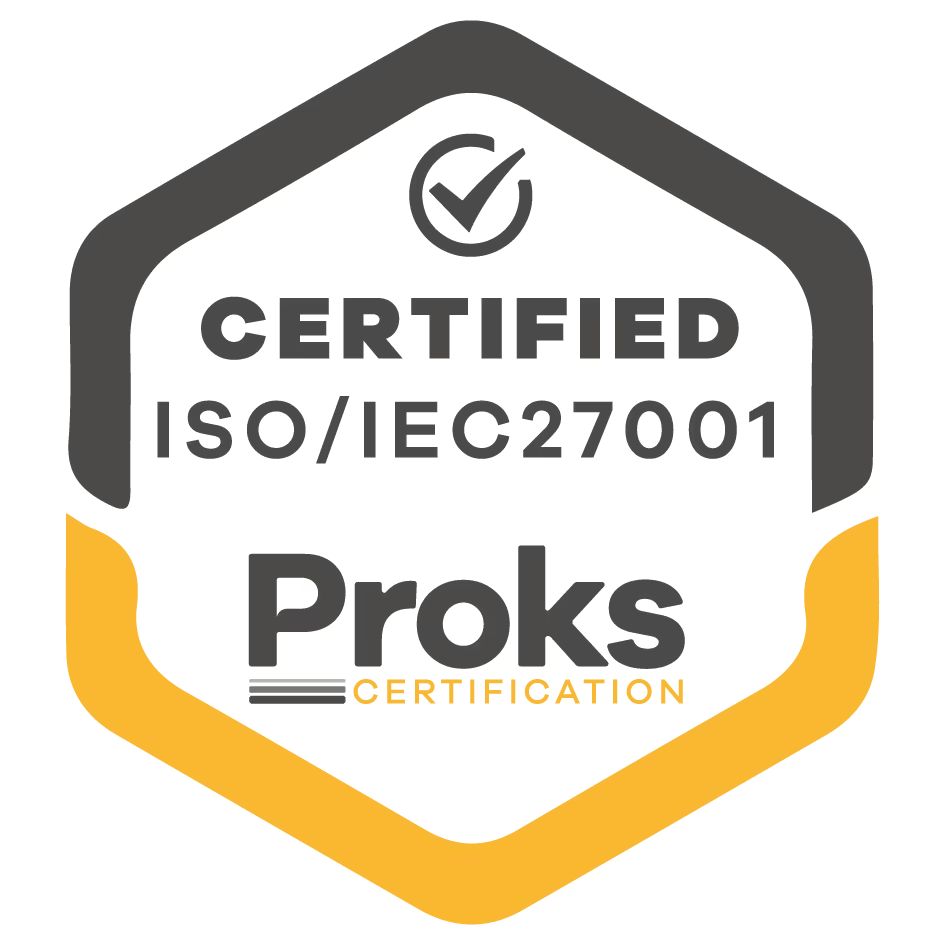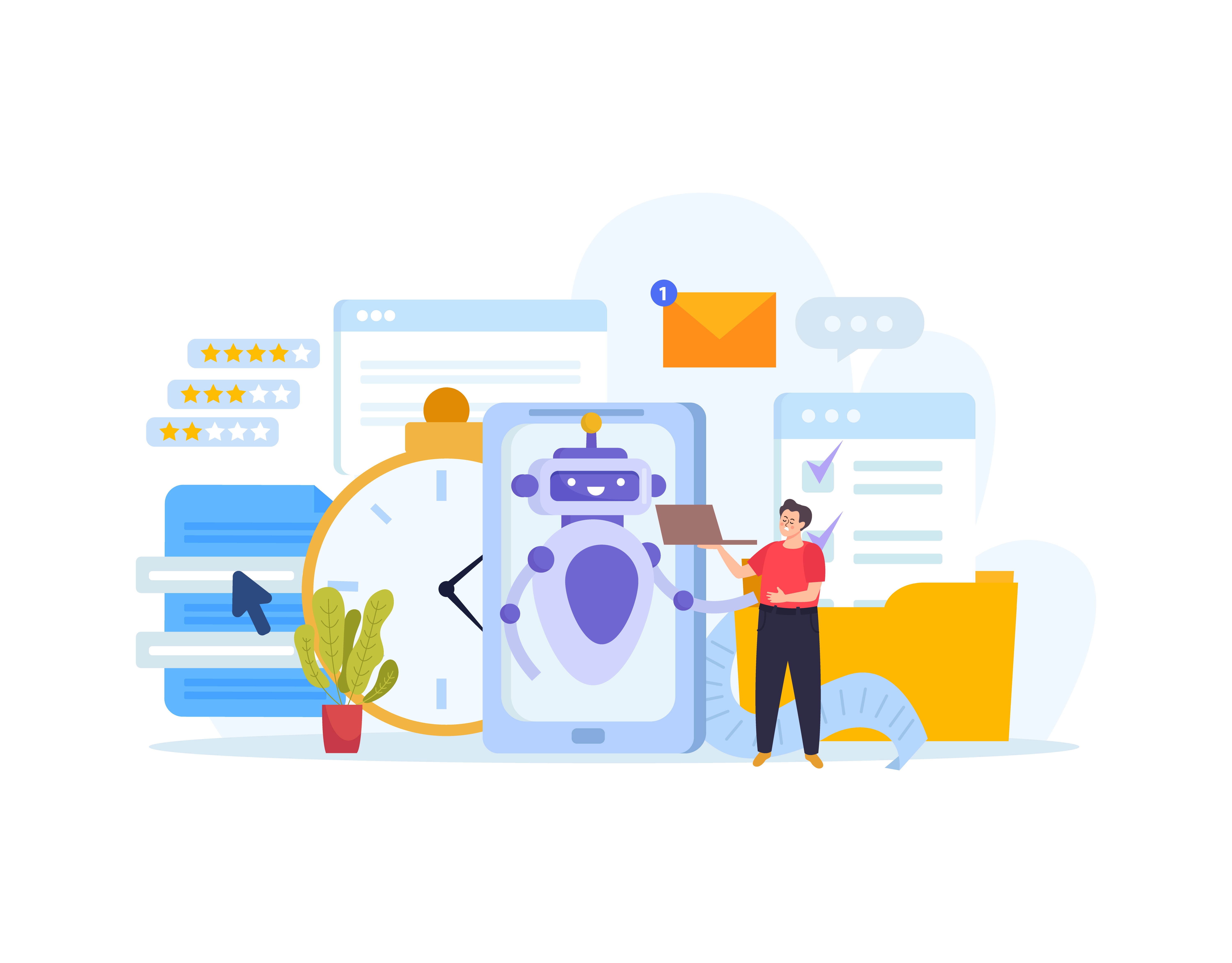

What Is Procure to Pay (P2P) and How Does The Process Work
Procure-to-pay (P2P) is a core business process that every company relies on, yet it’s often full of manual work, delays, and hidden costs. Inefficiencies in the P2P cycle can cost businesses up to 20% of their procurement spend according to McKinsey. In an era of tight margins, labor shortages, and digital transformation, optimizing the procure to pay process has become a top priority for executives. Modern technologies (especially AI and automation systems) are changing the game, enabling companies to streamline P2P from end to end.

Source: turian, with data extracted from McKinsey.
This article explains what procure-to-pay is, how the P2P process works, and how to optimize it through automation. We’ll also highlight the advantages of an automated P2P process and how AI solutions can help businesses achieve a faster, error-free P2P cycle.
What Is Procure-to-Pay?
Procure-to-pay (P2P) (also known as purchase-to-pay or procurement-to-payment) is the end-to-end process of requisitioning, purchasing, receiving, and paying for goods or services in a company. In simple terms, it covers every step from identifying a purchasing need all the way to issuing payment to the supplier. P2P integrates procurement activities with accounts payable (AP) activities to ensure a seamless workflow that enhances efficiency, accuracy, and financial control.
The procure-to-pay process begins when an employee or department identifies a need and requests a product or service. It then encompasses supplier selection (if not already predetermined), issuing a purchase order, receiving the goods or services, verifying and matching the supplier’s invoice, and finally processing the payment.
Why does P2P matter? A well-managed P2P process achieves the following:
- Ensures that organizational spending is controlled and compliant.
- Prevents unauthorized purchases, enforces budget limits and contract terms, and helps avoid costly errors or fraud.
- Provides visibility into spending patterns and commitments by centralizing procurement data and workflows, which allows companies to negotiate better terms with suppliers and identify cost-saving opportunities.
- Improves supplier relationships by ensuring vendors are paid accurately and on time, contributing to a healthier supply chain.
Procure-to-pay is critical for operational efficiency, financial discipline, and strategic procurement management.
How Does Procure To Pay Work? The Steps of the P2P Process
The procure to pay process involves a series of sequential steps that cross over from procurement into accounts payable. While organizations might have slight variations in this process, the P2P process generally includes the following key steps:
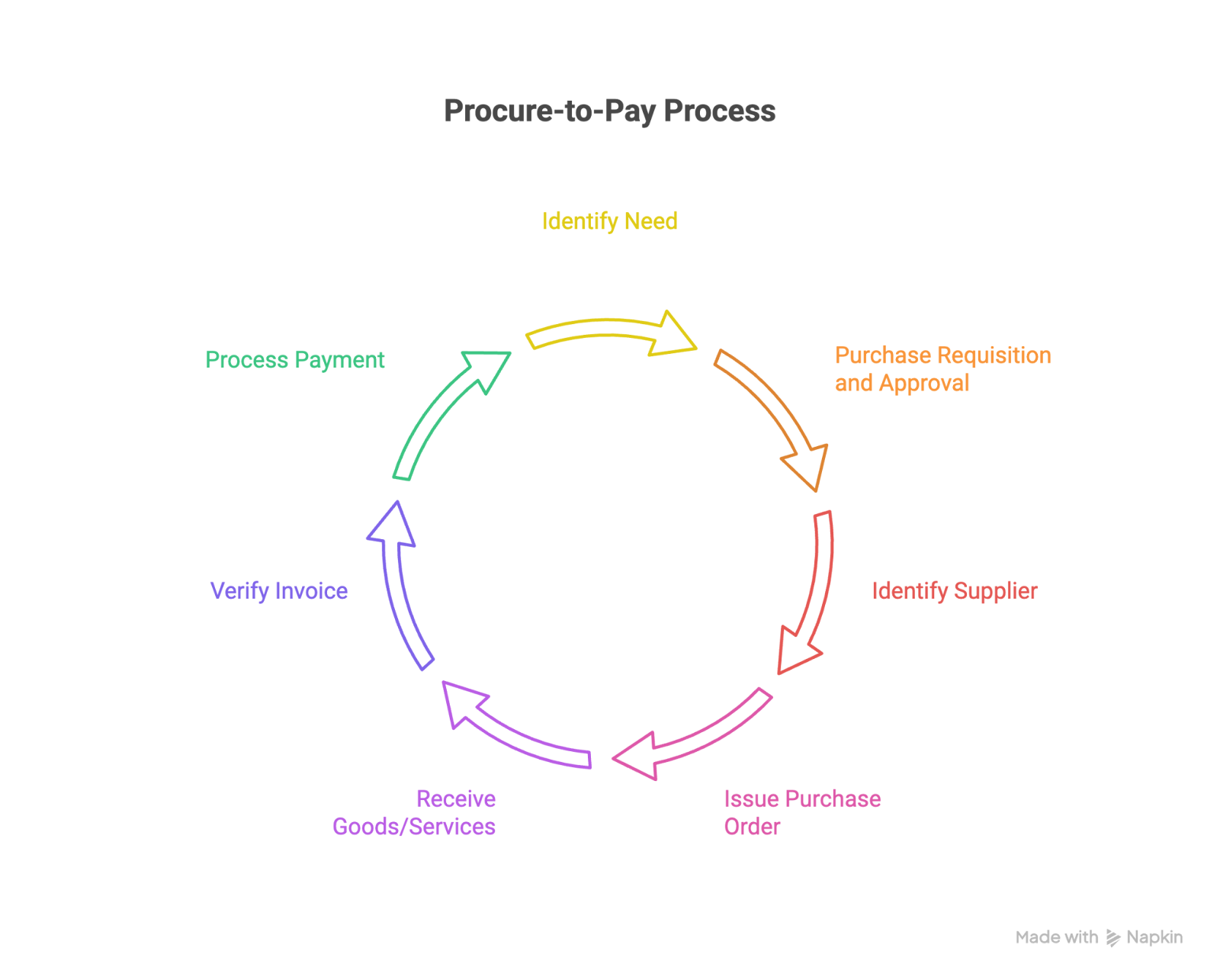
1. Need Identification
The process starts when someone in the organization identifies a need for a product or service. For example, a department might realize it’s low on certain raw materials or an employee needs a new software license. At this stage, the requirements (quantity, specifications, timing) are defined clearly. This ensures that only necessary purchases begin the workflow.
2. Purchase Requisition and Approval
The next step is to formalize the need into a purchase requisition (an internal request to buy the item). The requisition includes details like what’s needed, why, the estimated cost, and the desired vendor if known. The requisition is then submitted through the proper channel and routed for approval to the appropriate managers or budget owners. Approval workflows ensure that the purchase is justified and aligns with the company’s budget and procurement policies. Only once the requisition is reviewed and approved (often through an e-procurement system or internal portal) does it move forward. This control step helps prevent unauthorized or off-budget spending.
3. Supplier Identification (Sourcing)
In many cases, if the item is not already under contract or a preferred vendor isn’t pre-set, the procurement team will identify potential suppliers and obtain quotes. This sourcing step may involve comparing vendors on price, quality, delivery times, or other criteria. If a preferred supplier is already in place or it’s a recurring purchase, this step may be minimal. Once a supplier is selected, the process proceeds to ordering.
4. Purchase Order Issuance
After approval (and supplier selection, if needed), the purchasing department creates a Purchase Order (PO). The PO is a formal order document issued to the supplier, detailing the exact item or service being purchased, the agreed quantity, price, delivery date, delivery address, and other terms and conditions. Essentially, it’s the company’s offer to buy under specified terms. Once the PO is generated, it is sent to the supplier for confirmation. This step is crucial as it forms a binding agreement: the supplier will reference the PO when fulfilling the order.
5. Receiving Goods or Services
The supplier delivers the goods or performs the services as per the order. Upon receipt, the company verifies that the delivery matches the PO in terms of quantity and quality. For physical goods, this often involves checking the shipment against the purchase order and packing list, then creating a goods receipt or delivery confirmation record. For services, a team member might confirm that the service was completed satisfactorily. Any discrepancies (e.g., missing items, damaged goods, or variances from the order) are noted and communicated back to the supplier for resolution.
6. Invoice Received & Matching
After delivering the product or service, the supplier issues an invoice to request payment. The invoice typically arrives at the accounts payable department (often via email or an AP system). In the P2P cycle, a critical control is the 3-way match: the AP team (or the system) matches the supplier’s invoice against the corresponding PO and the receiving document. The goal is to ensure that the company is billed only for what was ordered and received, at the correct prices. If the invoice matches the PO and receipt, it can be approved for payment. If there are discrepancies, the system flags an exception. Such exceptions might route back to the procurement team or a manager for investigation and resolution before approval. Invoice matching and approval is often the most time-consuming part of P2P if done manually, but it’s crucial for preventing overpayments or fraud.
Invoice matching and approval is often the most time-consuming part of P2P if done manually, but it’s crucial for preventing overpayments or fraud.
7. Payment (Accounts Payable)
Once an invoice is approved, the final step is paying the supplier. The AP department issues payment according to the agreed payment terms (e.g. net 30 days, net 60 days). In modern systems, this step can be automated through an ERP or payment platform that queues up approved invoices for payment on their due dates. When the payment is made, the transaction is recorded in the financial system, and the P2P cycle is complete for that purchase.
Each of these steps may involve different people, departments, and systems. The cross-functional nature of procure-to-pay is one reason it can be challenging. If the process is manual or fragmented, the complexity and opportunities for error may increase. Different departments might use separate systems or spreadsheets, leading to data silos and confusion. A lack of unified process can also result in policy non-compliance (e.g. bypassing procurement rules) and lack of visibility into spend. These pain points drive many organizations to seek improvements and automation in their P2P process, as we’ll discuss next.
How To Optimize Your P2P Process
Many mid-sized companies today find that their procure to pay process is not as efficient or transparent as it could be. Common issues include paper-based or email-based workflows, disconnected procurement and accounting systems, delayed approvals, and errors in manual data entry. Optimizing the P2P process means addressing these pain points to create an improved workflow. Here are several strategies to optimize your P2P process:
Implement an Integrated P2P Software Solution
One of the most effective steps is to digitize and automate the P2P workflow using a comprehensive solution (or integrated set of tools). An automated system centralizes all steps in one workflow: requisitions, POs, goods receipt, invoicing, and payments are managed in a single platform with consistent data. By adopting procurement automation tools, companies can drastically cut down on paperwork and email trails, leading to faster cycle times and fewer errors.
Ensure Policy Compliance and Control
A key aspect of optimization is embedding procurement policies into the process. This means using tools and workflows that enforce compliance by design, for instance, a “No PO, No Pay” rule; catalogues or guides for employees to choose among approved suppliers, or approval hierarchies and budget checks. Automating controls not only prevents waste and fraud, but also saves time compared to chasing down unauthorized purchases after the fact.
Leverage Data and Analytics
Establish measurable KPIs for the procure-to-pay process and track them. Common P2P metrics include purchase order cycle time, invoice processing time, first-time match rate, invoice exception rate, cost per invoice/PO, on-time payment rate, and spend under management. By monitoring these indicators, you can identify bottlenecks or areas for improvement. For instance, if invoice exception rates are high, you might need to analyze why: are certain suppliers frequently sending incorrect invoices? Are there issues in the receiving process?. Modern P2P automation solutions often come with reporting dashboards; if not, consider exporting data to analyze it. The insights gained can inform process tweaks and help improve workflows.
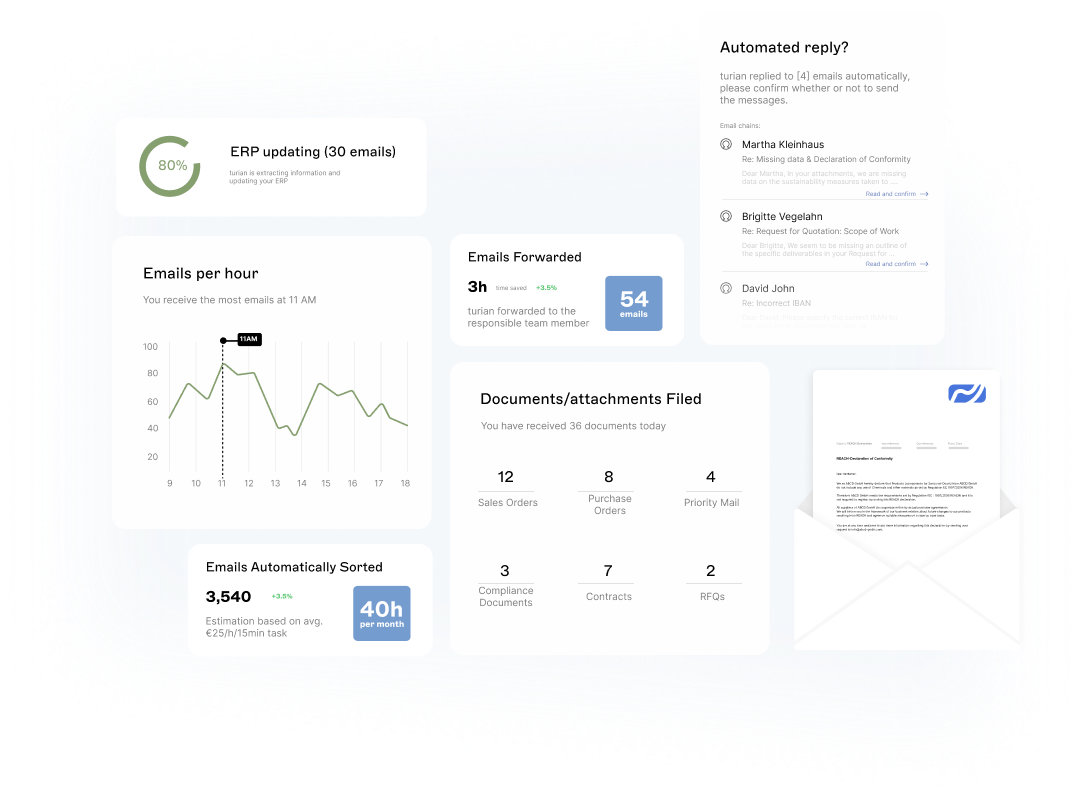
Adopt AI and Advanced Automation for Complex Tasks
Modern AI technologies go beyond traditional automation, handling tasks that involve unstructured data or higher-level decision-making. For instance, AI-based data extraction can intelligently read invoices or emails; AI agents can check contracts for compliance, or converse with users to complete purchase requests. Companies should explore AI-driven solutions such as intelligent invoice processing systems, chatbot assistants for procurement queries, or even autonomous procurement “agents” that can interact with humans.
{{cta="/cta/automate-operational-procurement-with-ai-agents"}}
The Advantages of an Automated Procure to Pay Process
Transforming a manual P2P process into an automated, optimized one can yield huge benefits for an organization. Let’s highlight some of the major advantages of automating the procure to pay process:
Cost Reduction and Efficiency Gains
Automation drives substantial cost savings by eliminating many of the labor-intensive tasks in procurement and AP. Consider invoice processing as an example: manually processing a single invoice costs around €15 on average (due to staff time for data entry, validation, follow-ups), whereas an automated invoice process can cost as little as €2–3 per invoice. That is an 80–85% reduction in cost per transaction. Across hundreds or thousands of invoices and purchase orders, the savings add up significantly.
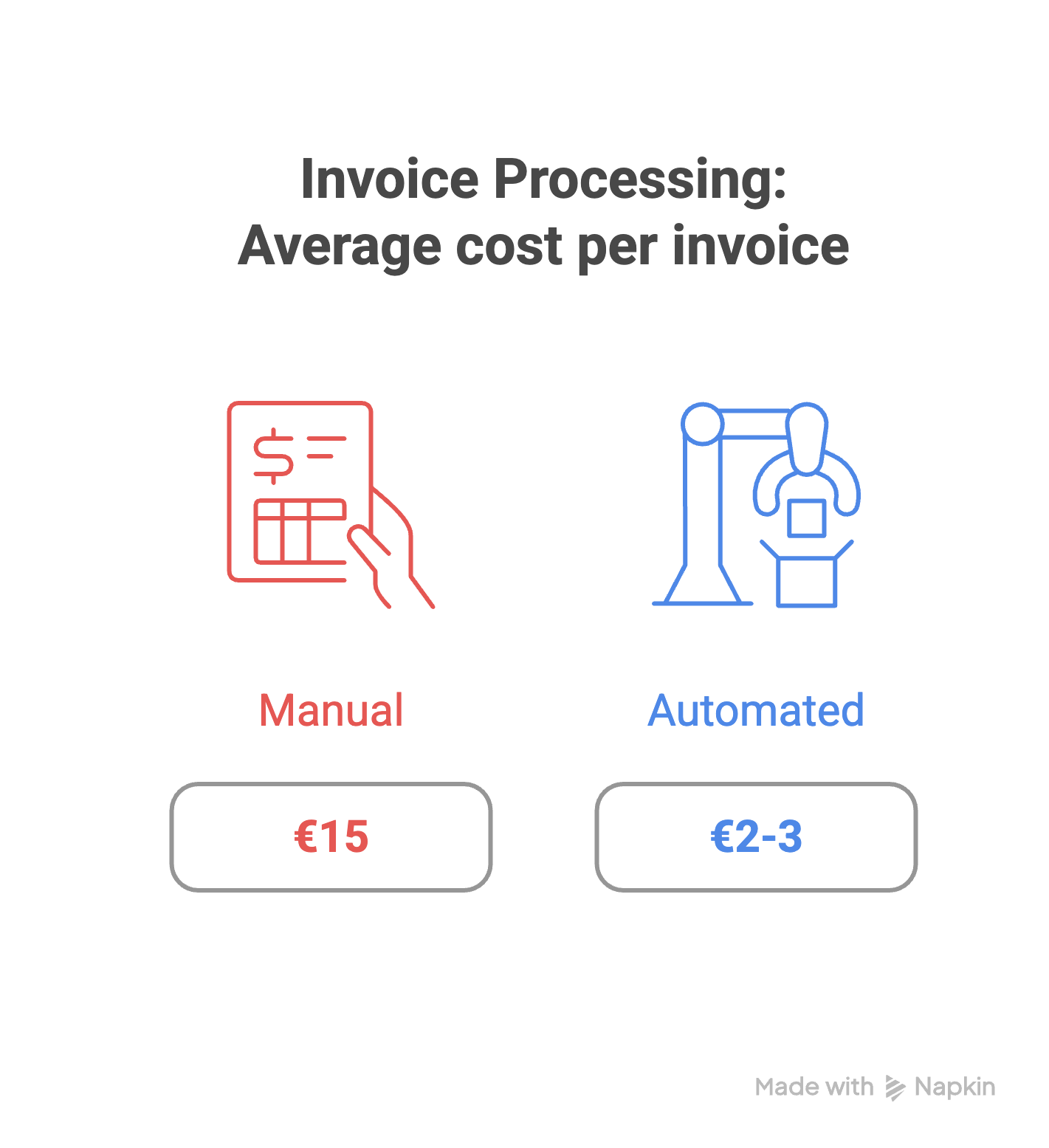
These efficiencies come not just from labor savings, but also from avoiding late fees, capturing early payment discounts, and reducing overpayments. Automation also improves productivity: your team can handle a larger volume of purchasing with the same or fewer resources.
Faster Cycle Times (Speed to Completion)
An automated procure-to-pay cycle moves much faster, which supports the business with timely purchasing and payments. In a traditional process, a purchase requisition might sit waiting for approvals for days, or an invoice might take two to three weeks to get fully processed. Automation accelerates each step: digital workflows send approvals instantly to the right person (with automatic reminders), purchase orders can be generated in minutes, and invoices can be matched and approved within hours instead of days. For example, studies found the average manual invoice takes 14.6 days to process, whereas leading AP automation can cut that down dramatically. Faster cycle times mean your suppliers get paid on time (or even early, which might earn early payment discounts), and your operations get the supplies/services they need without delay.
Improved Accuracy and Fewer Errors
Humans make mistakes: they mistype figures, misplace documents, or overlook approvals. An automated P2P system greatly reduces errors by enforcing rules and using digital data capture. For example, automated 3-way matching will catch discrepancies between an invoice and PO every time, whereas a busy employee might miss a small overbilling. Automated processes can usually reach a 99% of accuracy, which would be almost impossible for humans to achieve. The result is a more reliable, compliant process.
Greater Visibility and Control
When the process is automated, all data is captured in one system of record, instead of being scattered in filing cabinets, individual email inboxes, or Excel spreadsheets. This centralized data allows for clear and organized reports on spend. Teams can easily see commitments before they become expenses, track accruals, and ensure policy compliance in real time. Moreover, you can monitor supplier performance (e.g. identify if certain vendors frequently deliver late or invoice incorrectly). With automation systems, everything becomes trackable and transparent.
How turian Can Help You
Optimizing the procure-to-pay process can sound like a daunting challenge – especially for mid-sized companies that may lack large IT teams or massive budgets for enterprise software. This is where turian comes in. turian is an AI company specializing in using agentic AI frameworks to automate complex business processes end-to-end.
For P2P, this means the AI can read and understand emails, documents, and system data just like a human would, but at digital speed and scale. For example, turian’s AI procurement agent can automatically process incoming purchase requests and supplier communications. It can extract data from an emailed purchase order confirmation or a supplier’s quote attached in PDF, validate it against your original order, and then update your ERP system with a single click. If there’s missing information or a discrepancy, the AI detects it and flags it. All of this happens with minimal human intervention, the AI agent handles the back-and-forth, only escalating to a human manager if a complex exception or approval is needed through a human-in-the-loop process. turian AI becomes a digital procurement assistant that never gets tired of the paperwork.

On the accounts payable side, turian offers an AI invoicing assistant (part of its E-Invoicing solution) to automate invoice processing from start to finish. This AI system automatically reads supplier invoices (from email attachments or scans), extracts all the relevant fields, and then verifies that data by matching the invoice to the purchase order and goods receipt in the system. It can check calculations, detect duplicates, and apply business rules. Once everything checks out, the AI posts the invoice into the ERP or accounting software and forwards it for payment approval if required. If the invoice has an issue (e.g., it doesn’t match the PO, or there’s an unapproved charge), the AI flags it for a human to review or can even initiate a predefined exception workflow.
Another advantage is that turian integrates into your existing environment. The AI agents can plug into your email system (Outlook or Gmail) to read and send messages, and connect to your ERP (such as SAP, Microsoft Dynamics, Oracle NetSuite, etc.) via APIs to pull or push data. This means you don’t have to rip-and-replace your current systems to use turian. The AI acts as a smart layer on top, orchestrating the process across systems.
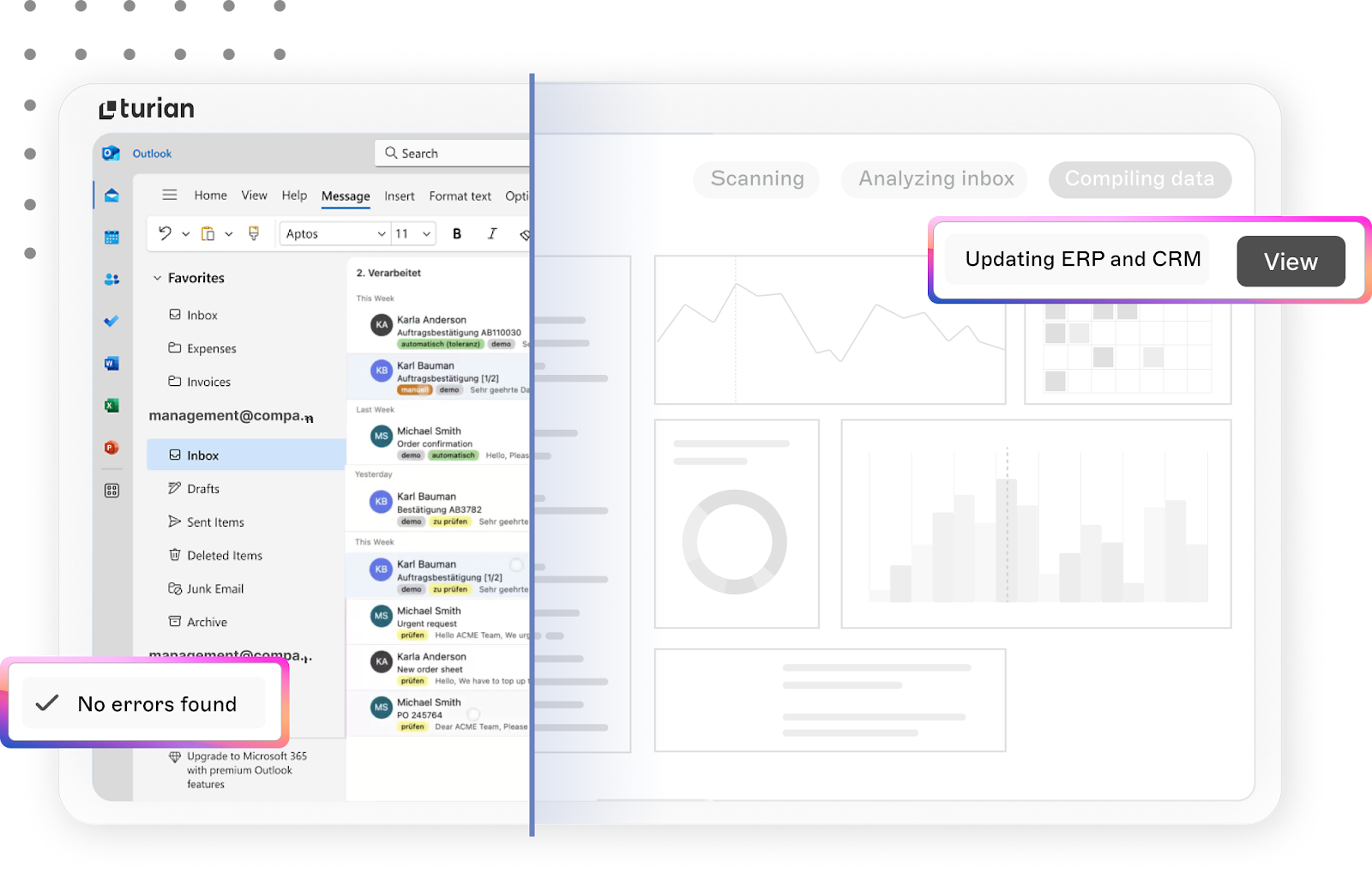
This kind of solution addresses a critical need: doing more with limited staff and standardizing processes without huge upfront costs.
turian can help your P2P process by providing a flexible AI workforce that automates the majority of tasks involved in requisitioning, ordering, receiving, and paying. It brings the latest generative AI technology into practical use, delivering high accuracy and reasoning abilities to what were once tedious manual chores. With turian’s AI handling the heavy lifting, your human employees can focus on what really matters: strategic negotiations, supplier relationships, and overseeing exceptions. The bottom-line is a faster, leaner procure-to-pay cycle that saves money, improves reliability, and scales as your business grows. turian’s vision is to enable exactly this kind of hybrid human-AI team in back-office functions, and P2P is a perfect example where an AI “coworker” can deliver significant value.
{{cta="/cta/turn-your-inbox-into-a-supply-chain-cockpit"}}




